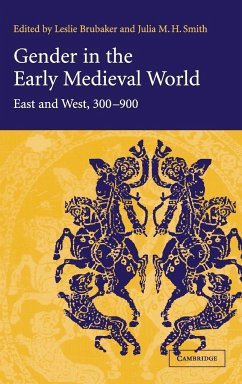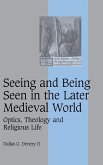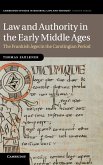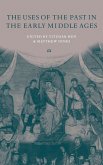Short description/annotation
This book analyses changes in gender pattern to examine early medieval European culture and society.
Main description
Gender analysis is one of the most probing ways to understand both power and cultural strategies in pre-industrial societies. In this book, sixteen scholars on the cutting edges of their disciplines explore the ideas and expressions of gender that characterised the centuries from c. 300 to 900 in milieux ranging from York to Baghdad, via Rome and Constantinople. Deploying a variety of disciplines and perspectives, they draw on the evidence of material culture as well as texts to demonstrate the wide range of gender identities that informed the social, political and imaginary worlds of these centuries. The essays make clear that the fixed point in the gender systems of the period was constituted by the hegemonic masculinity of the ruling elite, marginalised groups often invisible as historical subjects in their own right were omnipresent in, and critical to, the gendered discourses which buttressed assertions of power.
Table of contents:
1. Introduction Julia M. H. Smith; Part I. Gender in Late antique, Byzantine and Islamic Societies: 2. Gender and ethnicity in the early middle ages Walter Pohl; 3. Clothes maketh the man: power dressing and elite masculinity in the later roman world Mary Harlow; 4. Social transformation, gender transformation: the court eunuch, 300-900 Shaun Tougher; 5. Sex, lies and textuality: the secret history of Prokopios and the rhetoric of gender in sixth-century Byzantium Leslie Brubaker; 6. Romance and reality in the Byzantine brideshows Martha Vinson; 7. Men, women and slaves in Abbasid society Julia Bray; 8. Gender and politics in the harem of al-Muqtadir Nadia Maria El Cheikh; Part II. Gender in Germanic Studies: 9. Dressing conservatively: women's brooches as markers of ethnic identity(?)33; Bonnie Effros; 10. Gendering courts in the early medieval west Janet L. Nelson; 11. Men, women and liturgical patronage of culture in Merovingian Gaul Yitzhak Hen; 13. Genealogy defined by women: the case of the Pippinids Ian Wood; 14. Brideshows revisited: praise, slander and exegesis in the reign of the Empress Judith Mayke de Jong; 15. 'What is the word if not semen(?)33;' Priestly bodies in Carolingian exegesis Lynda Coon; 16. Negotiating gender, family and status in Anglo-Saxon burial practices, c. 600-950 Dawn Hadley.
Hinweis: Dieser Artikel kann nur an eine deutsche Lieferadresse ausgeliefert werden.
This book analyses changes in gender pattern to examine early medieval European culture and society.
Main description
Gender analysis is one of the most probing ways to understand both power and cultural strategies in pre-industrial societies. In this book, sixteen scholars on the cutting edges of their disciplines explore the ideas and expressions of gender that characterised the centuries from c. 300 to 900 in milieux ranging from York to Baghdad, via Rome and Constantinople. Deploying a variety of disciplines and perspectives, they draw on the evidence of material culture as well as texts to demonstrate the wide range of gender identities that informed the social, political and imaginary worlds of these centuries. The essays make clear that the fixed point in the gender systems of the period was constituted by the hegemonic masculinity of the ruling elite, marginalised groups often invisible as historical subjects in their own right were omnipresent in, and critical to, the gendered discourses which buttressed assertions of power.
Table of contents:
1. Introduction Julia M. H. Smith; Part I. Gender in Late antique, Byzantine and Islamic Societies: 2. Gender and ethnicity in the early middle ages Walter Pohl; 3. Clothes maketh the man: power dressing and elite masculinity in the later roman world Mary Harlow; 4. Social transformation, gender transformation: the court eunuch, 300-900 Shaun Tougher; 5. Sex, lies and textuality: the secret history of Prokopios and the rhetoric of gender in sixth-century Byzantium Leslie Brubaker; 6. Romance and reality in the Byzantine brideshows Martha Vinson; 7. Men, women and slaves in Abbasid society Julia Bray; 8. Gender and politics in the harem of al-Muqtadir Nadia Maria El Cheikh; Part II. Gender in Germanic Studies: 9. Dressing conservatively: women's brooches as markers of ethnic identity(?)33; Bonnie Effros; 10. Gendering courts in the early medieval west Janet L. Nelson; 11. Men, women and liturgical patronage of culture in Merovingian Gaul Yitzhak Hen; 13. Genealogy defined by women: the case of the Pippinids Ian Wood; 14. Brideshows revisited: praise, slander and exegesis in the reign of the Empress Judith Mayke de Jong; 15. 'What is the word if not semen(?)33;' Priestly bodies in Carolingian exegesis Lynda Coon; 16. Negotiating gender, family and status in Anglo-Saxon burial practices, c. 600-950 Dawn Hadley.
Hinweis: Dieser Artikel kann nur an eine deutsche Lieferadresse ausgeliefert werden.








